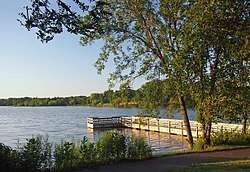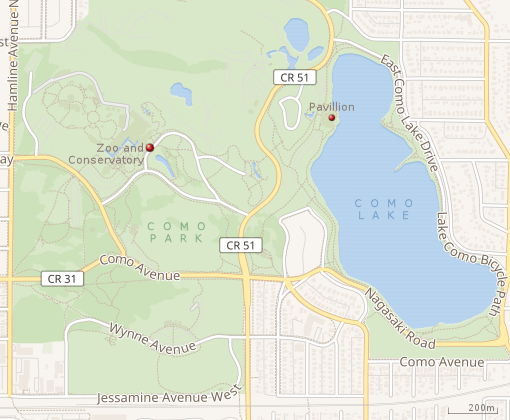Como Lake (Minnesota)
Como Lake is a 70.5-acre (285,000 m2)[1] lake up to 15.5 feet (4.7 m) deep in St. Paul, Minnesota, United States.[2] It, along with the neighboring Como Park, has been a recreation area for residents of the Twin Cities for more than a century. It was named in 1848 by local farmer Charles Perry. A pavilion sits on the west side of the lake, and plays host to theatrical performances and concerts during the warmer months. The park features a variety of attractions, including the Como Park Zoo and Conservatory and the Como Regional Park Pool which are heavily used whenever good weather beckons people to go outside.[3]
| Como Lake | |
|---|---|
 The south end of Como Lake | |
 Como Lake | |
| Location | St. Paul, Minnesota |
| Coordinates | 44°58′45″N 93°08′26″W |
| Basin countries | United States |
| Surface area | 70.5 acres (285,000 m2) |
| Max. depth | 15.5 ft (4.7 m) |
| Water volume | 468.8 acre feet (578,300 m3) |
 |
| Como Lake and Park, St. Paul, Minnesota, |
History
After James-Younger Gang member Charlie Pitts was killed in the chaotic aftermath of the disastrous September 7, 1876 Northfield, Minnesota raid, his body was boxed up and temporarily submerged in the lake by Dr. Henry Hoyt, a local physician who wanted the bleached skeleton as a display piece for his office. The skeleton was on display for unknown number of years at the Stage Coach Museum in Shakopee, Minnesota. In 1981 the remains were donated to the Northfield Historical Society. Currently the skeleton is housed in the Physical Anthropology Lab at Minnesota State University in Mankato awaiting analysis.
Fish
The lake contains black bullhead, black crappie, bluegill, golden shiner, green sunfish, hybrid sunfish, northern pike, pumpkinseed, walleye, white sucker, yellow bullhead, and yellow perch.[2] Some fish consumption guideline restrictions have been placed on the lake's bluegill, bullhead, crappie, largemouth bass, northern pike, and walleye due to mercury and/or PFOS contamination.[2]
References
- "2016 Lakes Monitoring Report" (PDF). Capitol Region Watershed District. Capitol Region Watershed District. 2017-03-16. Archived from the original (PDF) on 2018-06-15. Retrieved 2018-06-14.
- "Lake information report: Minnesota DNR". MN DNR. MN DNR. 2006-08-02.
- "Como Regional Park". Saint Paul, Minnesota. 2015-10-19. Retrieved 2019-02-11.